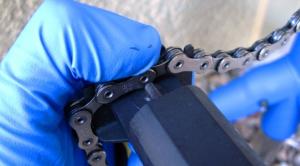What is the most efficient way to “buy” speed in the form of reduced drivetrain friction? There is a technology, not quite new, but not yet seen in the bike industry. If all parties execute up to their verbal warranties it's going to debut in our industry in a very few weeks.
First let’s report on the status quo. Last week Ceramic Speed bought the remainder of Friction Facts. The first stage in that purchase was the process by which drivetrain parts were subjected to a special preparation. Ceramic Speed bought that process, known as the UltraFast Optimization (UFO) chain, and the Friction Facts owner, the well-regarded Jason Smith, retained his independent testing facility.
Last week Ceramic Speed bought that too. The Danish ceramic bearing and bicycle component manufacturer brought Mr. Smith aboard as its Chief Technology Officer.

The process Mr. Smith designed, and which Ceramic Speed bought, gives the rider a projected 2 to 5 watts “on competition day.” After 200 miles “under clean riding conditions" the chain still contains “traces” of the treatment. The 11-speed version of the chain costs $135.
A new company, PremierBike, is soon to release its own new tri bike for sale. In addition it is about to begin selling its own “optimized” chains. These are alleged by PremierBike to offer benefits that are much longer lasting than the technology Ceramic Speed is currently using.
The idea is to reduce "parasitic drag” through a surface treatment process known by the acronym CAVSF. It stands for chemically accelerated vibratory surface finishing, and the process is described in detail elsewhere.
PremierBike’s owner, Dan Kennison, has built a suite of businesses over his adult life and one involved this process used to treat engine parts in high performance race cars. In a discussion I had with Mr. Kennison he stated that Indy car engines so-treated would last about three times longer. Working with Indy cars formed the basis of Mr. Kennison’s business, but he said he knew of other companies performing the same basic service for those on the NASCAR circuit.
The operative metric is R(a), which is average roughness in μ-in, that is, micro-inches (millionths of an inch). In layman’s terms, removing the microscopic peaks from surfaces that rub and wear against each other decreases friction, which increases performance and extends life.
Rather than cleaning the factory lube off and adding a wax/PTFE lube mixture, which is how Mr. Kennison describes the process as executed by Ceramic Speed, the chain is first subjected to an isotropic surface process (CAVSF). Kennison’s company then adds to this the surface impregnation process in combination with the typical wax/PTFE/MSO2 coating, that is to say, he first makes the chain surfaces smoother, and then he does something akin to what Ceramic Speed does during its chain treatment.
The numbers I’ve seen are a reduction in the R(a) (surface roughness) of about one-third on each of several chains tested, meaning the R(a) decreases by about a third (the number gets a third of the way from where it starts to zero). Mr. Kennison subjected several chains to the process, recording R(a) before and after. In each case R(a) was reduced by about one-third. He also found, surprisingly, that Wippermann chains had less surface roughness before his CAVSF process than other chains had after the process. In other words Wippermann chains begin their lives very smooth. Nevertheless, Wippermann chains also saw about a one-third reduction in R(a) after the CAVSF process. It is a standard, untreated, stock Wippermann 11sx chain pictured here.
Mr. Kennison expects to sell new post-process chains consumer direct for a price in the $105 to $110 neighborhood. He will use Wippermann Connex 11sx chains, which are nickel chains with stainless inner links. That chain, untreated, from Wippermann, sells for $89 to $99 in the U.S., and $59 from ChainReactionCycles in the UK, as of today. The chain will go through the CAVSF process, followed by a wax/PTFE/MSO2 coating. That latter coating will only lasts 200 or so miles, just as with chains sold today, similarly treated. But the PremierBike chain, according to Mr. Kennison, will then retain all the benefits afforded by the CAVSF process: longer life, less friction. These chains will work on both SRAM and Shimano-outfitted bikes.
At face value it seems an astoundingly good deal, if a chain that costs not much more than an untreated chain will last twice or thrice as long; will lose less power through friction; and will still come with the slippery coating. But the chain is not for sale yet, and I haven’t seen it, touched it, ridden it.
Mr. Kennison said he expects to begin selling chains to consumers on or about the 1st of December, 2016. There is no site or place to send Slowtwitchers at the moment. Expect a future article when contact and purchase info is forthcoming. As Mr. Kennison is a habitué on the Slowtwitch Reader Forum, he will probably field questions there.



